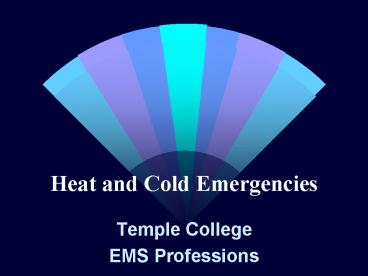Heat and Cold Emergencies - PowerPoint PPT Presentation
1 / 32
Title:
Heat and Cold Emergencies
Description:
... if possible Prevent further heat loss Do not aggressively rewarm Treatment for Hypothermia Avoid rough handling Transport Hypothermia can cause apparent ... – PowerPoint PPT presentation
Number of Views:106
Avg rating:3.0/5.0
Title: Heat and Cold Emergencies
1
Heat and Cold Emergencies
- Temple College
- EMS Professions
2
Heat/Cold Emergencies
- Metabolism runs best at 98.6oF
- T0 - Metabolic rates cell damage
- T0 - Metabolic rates cell damage
3
Body Temperature Maintenance
- Balancing Heat
Production, Heat Loss
4
- Heat Production
- Metabolism
- Movement of Large Muscles
- Shivering
- Heat Loss
- Radiation
- Conduction
- Convection
- Evaporation
- Respiration
5
- Heat Production gt Heat Loss Body
Temperature - Heat Loss gt Heat Production Body Temperature
6
Heat/Cold Illness Results from
- Effects of or body temperature
- Effects of attempting to compensate for changes
in heat production, heat loss
7
Heat Illness
8
Heat Cramps
- Due to salt loss from sweating
- Spasms in large muscle groups
- Patient awake, alert
9
Heat Cramps Treatment
- Stop activity
- Cool environment
- Balanced salt solution
- Do not give salt or water alone
10
- What would be the effect of giving only water
without salt to a patient with heat cramps?
11
Heat Exhaustion
- Sweating Blood volume
- Vasodilation Vascular volume
- Both decrease perfusion
12
Heat Exhaustion Signs, Symptoms
- Dizziness
- Weakness
- Faintness
- Headache
- Nausea, vomiting
- Pale, cool, moist skin
13
- Why do the signs/symptoms of heat exhaustion
resemble the signs/symptoms of shock?
14
Heat Exhaustion Treatment
- Stop activity
- Cool environment
- Lie down, elevate legs
- Balanced salt solution orally, if not
nauseated - Transport if LOC or symptoms do not clear
rapidly
15
Heat Stroke
- Most serious heat-related illness
- Body temperature gt 106oF
- Damage occurs to temperature regulating center in
brainstem - Sweating mechanism fails
16
Heat Stroke Types
- Classic
- Exertional
17
High Risk Groups Classic Heat Stroke
- Elderly
- Chronic medical problems
- Congestive heart failure
- Obesity
- Alcoholism
18
High Risk Groups Exertional Heat Stroke
- Small children in closed vehicles
- Athletes, military recruits, construction
workers, on hot humid days
19
Heat Stroke Signs/Symptoms
- Body temperature
- Hot, dry, flushed skin
- Absence of sweating
- Altered mental status
- Confusion, irritability
- LOC
- Coma
- Seizures
20
LOC Hot EnvironmentequalsHeat Strokeuntil
proven otherwise
21
Heat Stroke Treatment
- High concentration O2
- Assist ventilations as needed
- Rapidly cool to 102oF
- Transport
22
Cold Emergencies
23
Frostbite
- Localized cold injury
- Subfreezing temperatures
- Vasoconstriction occurs
- Blood flow to distal circulation (nose,
ears, fingers, toes) - Water in tissues freezes tissue damage occurs
24
Frostbite Signs/Symptoms
- Mild (frost nip) Red, burning areas
- Superficial White, waxy, doughy-feeling
- Deep Dead white, hard, no sensation
25
Frostbite Treatment
- Remove from cold
- Dry areas gently, wrap in sterile dressing
- Transport
- If transport prolonged, rewarm rapidly in
100-105oF water
26
Frostbite Treatment
- Do NOT rub frostbite
- Do NOT allow refreezing
- Do NOT allow patient to smoke
27
Hypothermia
- Generalized cooling of body
- Can occur at temperatures above freezing
28
Hypothermia Risk Groups
- Homeless
- Alcoholics
- Elderly living in poorly heated homes
- Outdoor sports participants
29
LOC Cool Environment equalsHypothermiauntil
proven otherwise
30
Hypothermia Treatment
- Support airway, breathing
- 100 O2--warmed, if possible
- Prevent further heat loss
- Do not aggressively rewarm
31
Treatment for Hypothermia
- Avoid rough handling
- Transport
32
Hypothermia can cause apparent absence of vital
signs
- Always resuscitate
- Youre not dead until youre warm and dead!































